| Paolo and Francesca | |
|---|---|
 | |
| Artist | Auguste Rodin |
| Year | 1885 |
| Medium | Bronze |
Paolo and Francesca is a sculptural group by Auguste Rodin, showing Paolo and Francesca da Rimini, damned lovers from Canto V of Dante's The Divine Comedy . [1]
| Paolo and Francesca | |
|---|---|
 | |
| Artist | Auguste Rodin |
| Year | 1885 |
| Medium | Bronze |
Paolo and Francesca is a sculptural group by Auguste Rodin, showing Paolo and Francesca da Rimini, damned lovers from Canto V of Dante's The Divine Comedy . [1]
The couple appeared in several of Rodin's initial drawings between 1880 and 1881 for The Gates of Hell . In the first version he placed them in the centre, in a work that later appeared on its own as The Kiss . This piece was removed from Gates by the artist in 1886 and replaced by a new version, closer to the description of the lovers in Dante's text. [2]

The Thinker is a bronze sculpture by Auguste Rodin, usually placed on a stone pedestal. The work depicts a nude male figure of heroic size sitting on a rock. He is seen leaning over, his right elbow placed on his left thigh, holding the weight of his chin on the back of his right hand. The pose is one of deep thought and contemplation, and the statue is often used as an image to represent philosophy.

Francesca da Rimini or Francesca da Polenta was a medieval noblewoman of Ravenna, who was murdered by her husband, Giovanni Malatesta, upon his discovery of her affair with his brother, Paolo Malatesta. She was a contemporary of Dante Alighieri, who portrayed her as a character in the Divine Comedy.

Francesca da Rimini: Symphonic Fantasy after Dante, Op. 32, is a symphonic poem by Pyotr Ilyich Tchaikovsky. It is a symphonic interpretation of the tragic tale of Francesca da Rimini, a beauty immortalized in Dante's Divine Comedy.
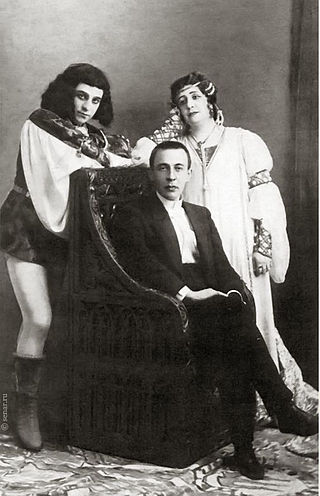
Francesca da Rimini, Op. 25, is an opera in a prologue, two tableaux and an epilogue by Sergei Rachmaninoff to a Russian libretto by Modest Ilyich Tchaikovsky. It is based on the story of Francesca da Rimini in the fifth canto of Dante's epic poem The Inferno. The fifth canto is the part about the Second Circle of Hell (Lust). Rachmaninoff had composed the love duet for Francesca and Paolo in 1900, but did not resume work on the opera until 1904. The first performance was on 24 January 1906 at the Bolshoi Theatre, Moscow, with the composer himself conducting, in a double-bill performance with another Rachmaninoff opera written contemporaneously, The Miserly Knight.

The Kiss is an 1882 marble sculpture by the French sculptor Auguste Rodin.

The Gates of Hell is a monumental bronze sculptural group work by French artist Auguste Rodin that depicts a scene from the Inferno, the first section of Dante Alighieri's Divine Comedy. It stands at 6 metres high, 4 metres wide and 1 metre deep (19.7×13.1×3.3 ft) and contains 180 figures.
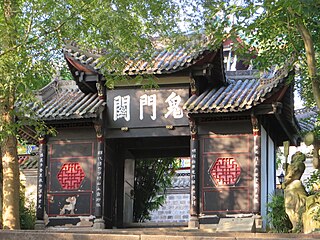
The gates of hell are various places on the surface of the world that have acquired a legendary reputation for being entrances to the underworld. Often they are found in regions of unusual geological activity, particularly volcanic areas, or sometimes at lakes, caves, or mountains.

Francesca da Rimini and Paolo Malatesta appraised by Dante and Virgil is a composition painted in at least six very similar versions by Ary Scheffer between 1822 and 1855; all are in oils on canvas. The paintings show a scene from Dante's Inferno, of Dante and Virgil in the shadows to the right viewing the murdered lovers Francesca da Rimini and Paolo Malatesta in Hell. It "could be described as Scheffer's best work".

Paolo and Francesca da Rimini is a watercolour by British artist and poet Dante Gabriel Rossetti, painted in 1855 and now in Tate Britain.

Eternal Springtime is a c. 1884 sculpture by the French artist Auguste Rodin, depicting a pair of lovers. It was created at the same time as The Gates of Hell and originally intended to be part of it. One of its rare 19th-century original casts belongs to the permanent collection of Calouste Gulbenkian Museum.

The Falling Man is a sculpture by French artist Auguste Rodin modeled in 1882 and is part of Rodin's emblematic group The Gates of Hell.

I Am Beautiful, also known as The Abduction, is a sculpture of 1882 by the French artist Auguste Rodin, inspired in a fragment from Charles Baudelaire's collection of poems Les Fleurs du mal.

Fugitive Love is a sculpture by Auguste Rodin made between 1886 and 1887, both sculpted in marble and cast in bronze. It represents a man and a woman embracing each other on top of a rock. More specifically, the author was inspired by the story of Francesca da Rimini's love affair with Paolo Malatesta, an allusion to Dante Alighieri's depiction of lust on the second circle of Hell in his Inferno.
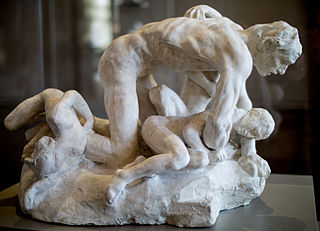
Ugolino and his sons is a plaster sculpture by French artist Auguste Rodin, part of the sculptural group known as The Gates of Hell. As an independent piece, it was exhibited by its author in Brussels (1887), Edinburgh (1893), Genoa (1896), Florence (1897), Netherlands (1899) and in his own retrospective in 1900.
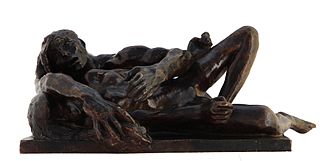
Avarice and Lust is a sculpture by French artist Auguste Rodin, conceived between 1885 and 1887, representing two of the seven capital sins and is part of his sculptural group The Gates of Hell, where it can be found in the lower part of the right door. It's possible that the name was inspired by Victor Hugo's poem Après une lecture du Dante:
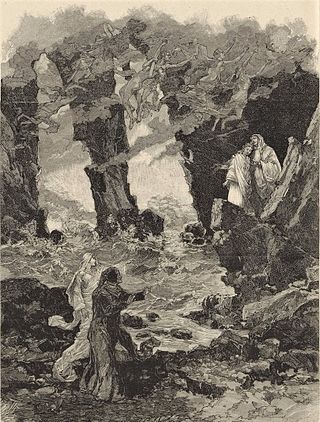
Françoise de Rimini is an opera in four acts with a prologue and an epilogue. The last opera composed by Ambroise Thomas, it sets a French libretto by Michel Carré and Jules Barbier which is based on an episode from Dante's Divine Comedy. The opera was first performed by the Paris Opera on 14 April 1882 but fell into relative obscurity until its revival in 2011.

Despair or Despair at the Gate is a sculpture by Auguste Rodin that he conceived and developed from the early 1880s to c. 1890 as part of his The Gates of Hell project. The figure belongs to a company of damned souls found in the nine circles of Hell described by Dante in The Divine Comedy. Other title variations are Shade Holding her Foot, Woman Holding Her Foot, and Desperation. There are numerous versions of this work executed as both plaster and bronze casts and carved marble and limestone.

Polyphemus is an 1888 sculpture by Auguste Rodin, showing Polyphemus and his love for the Nereid Galatea, as told in Book XIII of Ovid's Metamorphoses.
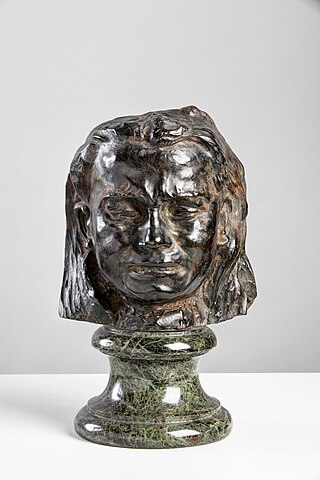
Mask of a Weeping Woman is a sculpture by Auguste Rodin, initially produced as a pair with Weeping Woman for the first version of his The Gates of Hell in 1885. The two pieces were intended to appear on the centre of each panel. They were later moved by Rodin himself, who instead placed Mask on the lower part of the left panel.

The second circle of hell is depicted in Dante Alighieri's 14th-century poem Inferno, the first part of the Divine Comedy. Inferno tells the story of Dante's journey through a vision of the Christian hell ordered into nine circles corresponding to classifications of sin; the second circle represents the sin of lust, where the lustful are punished by being buffeted within an endless tempest.